Abstract
High-intensity focused ultrasound (HIFU) is a noninvasive therapy that uses focused ultrasound to treat a part of the tissue; high temperatures can damage tissues by heat. HIFU has many applications in the field of surgery and aesthetics and is used increasingly in everyday life. In this article, we discuss the mainboard design that controls the HIFU system with the ability to create a multistep sine wave compatible with many different applications. The signal used to trigger the transducer is a sinusoidal signal with a frequency adjustable from 0.1 to 3 MHz. In addition, the power supplied to the HIFU transducer is also controlled easily by the configuration parameters installed in the control circuit board. The proposed control and design method generates a voltage signal that doubles the supply voltage, thereby reducing the current on the MOSFET. The hardware design is optimized for a surface-mounted device-type MOSFET without the need for an external heat sink. In tests, we conducted a harmonious combination of two output signals to activate the same HIFU probe. The results showed that the energy transferred to the HIFU transducer increased by 1.5 times compared to a single channel. This means that the HIFU treatment time is reduced when using this method, with absolutely no changes in the system structure.
1. Introduction
In recent years, high-intensity focused ultrasound (HIFU) has reemerged as a minimally invasive and nonionizing therapeutic modality for the treatment of a variety of solid tumors (both malignant and benign), including liver, prostate, breast, and soft-tissue sarcoma [1,2,3]. New biomedical applications of this therapeutic method are also being explored, such as hemostasis and gene therapy [4]. Pioneering studies have demonstrated that HIFU, with spatial-peak temporal-average intensities (IsPTa) between 500 and 104 W/cm2 at the beam focus [5], can produce necrotic lesions in deep-seated tissue through thermal coagulation and cavitation disruption, with minimal damage to the surrounding tissues [6,7,8].
In general, a HIFU system consists of at least two components: the HIFU transducer and the HIFU controller board [4,9,10,11,12]. The HIFU transducer converts stimulated electrical signals to create a focused ultrasound at one point and generate heat to burn cells. The HIFU controller board generates an electrical pulse signal to excite the HIFU transducer [13,14]. However, modern HIFU systems also incorporate other expansion devices, such as motion controllers or magnetic resonance imaging (MRI) systems, to increase the effectiveness of treatment [15,16]. HIFU transducers require a large amount of energy during work, so the transducer excitation signal is usually a bipolar pulse signal [17,18]. In bipolar pulse types, bipolar sine signals are often used in HIFU systems [9].
A lot of research has been conducted on HIFU, such as designing HIFU transducers, designing controllers for HIFU devices, and applying HIFU in medical treatment. Carlos Christoffersen and colleagues presented the practical implementation of an integrated MRI-compatible CMOS amplifier capable of directly driving a piezoelectric ultrasound probe suitable for HIFU therapy [19]. The amplifiers operate in class DE mode, without the need for an output matching network. The limitation of this study is that the HIFU controller circuit capacity is relatively small, at only 800 mW. Chris Adams and colleagues presented a design for the HIFU controller board based on reduced pulse-width modulation (PWM) (high-resolution PWM), proposed as an algorithmic solution to design a converted waveform [9]. In that study, the signal to trigger the HIFU transducer is a five-step modulated sine signal [9]. Jeesu Kim and colleagues presented a real-time system with a combination of the HIFU system and photoacoustic thermometry [20]. The HIFU system they used is quite large. In this study, we discuss the design of a complete HIFU controller board for real-time systems that can be combined with external devices, such as motion controllers and MRI systems.
This paper has three main contributions: the first is a complete HIFU system. We present this compact system with high amount of flexibility that can be used with many different types of probes (with frequency varying from 0.1 to 3 MHz). In addition, the transducer’s energy can be adjusted based on changing the transducer signals’ amplitude. The second HIFU transducer excitation signal is a five-step sinusoidal signal generated by the HIFU excitation module design on the field-programmable gate array (FPGA) platform for high flexibility, accuracy, and high-order harmonic suppression. The design consists of two channels that can generate two independent signals and can also be combined into one signal for higher power without changing the system switching structure. Third, we have calculated the parameters for the MOSFET control circuit to optimize the operation of the MOSFET and reduce the power dissipation. Specially designed heat sinks for MOSFET use a printed circuit as a heat sink to help compact design works with large capacity without the support of fans and external heat sinks.
The rest of this paper is organized as follows: Section 2 describes the completed design of the HIFU system. The implementation of the hardware and code is introduced in Section 3. Details of the setup for testing and the results are presented in Section 4. Finally, concluding remarks are given in Section 5.
2. Materials and Methods
Figure 1 presents the description of the HIFU system proposed in this article. The complete model of the HIFU transducer controller system consists of three main parts: the power supply module, the control signal generator module, and the high-power circuit module to trigger the HIFU transducer. The power supply module created three sets of dual power supplies (+/−48 V) and (+/−24 V) to power the circuit. The control circuit generates the trigger signal for the MOSFET. The power circuit generates the signal to control the HIFU transducer. The high-power circuit consists of N–P MOSFET pairs that generate a high current signal and trigger the HIFU transducer. The power supply for the system uses power with a voltage range of 48–60 V, and the signal amplifier is capable of amplifying the load current up to 10 A for the total power consumption on the HIFU probe to more than 100 W.
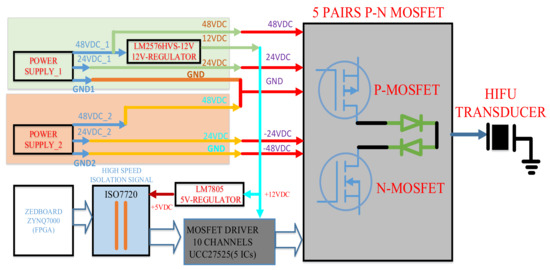
Figure 1.
Proposed HIFU controller system.
This design uses many power components with high switching frequency, so it also consumes a power source and dissipates a large amount of heat. The lifetime of all semiconductor devices is inversely proportional to their operating temperature. Within a switching device, there are two main losses: resistive and switching. Both increase the temperature of the switching device. The resistive element is an I2R loss due to the current through the device, and it is “on” resistance. Heat is also generated each time the device is switched on, due to its current voltage (IV) characteristic [21,22,23]. This loss is proportional to the switching frequency. The consideration of the cooling design for these components is an important issue mentioned in this study [24,25].
In addition, the MOSFET in the power circuit must also operate at high frequencies (about 2 MHz), so the calculation of circuit parameters in the schematic design and the arrangement of components in the layout also play an essential role in improving the output signal quality to trigger the HIFU transducer. Details of this design are presented in greater depth later in this article.
We proposed that a system can generate the HIFU transducer control signal with the sinusoidal waveform of five steps. We can easily control the power supplied to the transducer by controlling voltage levels during sine wave modulation. Some waveforms that can be generated by the model are presented in Figure 2.
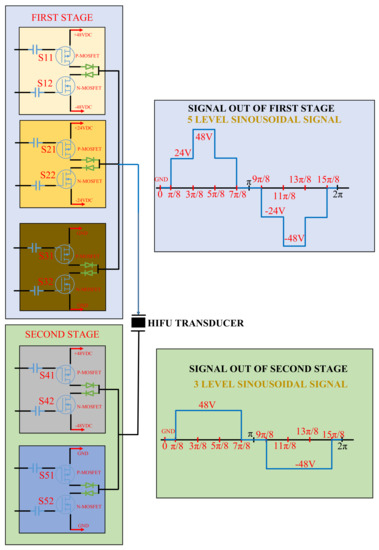
Figure 2.
Proposed HIFU signal generator method.
2.1. PCB Thermal Characteristics
In our design, the power components are the surface-mounted device (SMD) type, so the heat dissipation for selected printed circuit board (PCB) components does not use other external heat sink components. Important properties related to heat dissipation on PCBs are given priority in this section [26].
The FR-4 is one of the most commonly used PCB materials and is the National Electrical Manufacturers Association’s designation for a flame retardant, fiberglass-reinforced epoxy laminate. A by-product of this construction is that FR-4 has very low thermal conductivity. Figure 3a shows a typical cross-sectional geometry for a two-layered FR-4 board [22,27].

Figure 3.
(a) Structure of two-layered FR-4 PCB with thermal vias; (b) thermal vias.
Using the thermal conductivity values in Table 1, the thermal resistance for an FR-4 board can be calculated by adding the thermal resistances of the layers.

Table 1.
Typical thermal conductivities of FR-4 board layers including vias.
For a given layer, the thermal resistance is given by the formula:
where l is the layer thickness, λ is the thermal conductivity, and A is the area normal to the heat source.
2.2. Designing Thermal Vias
An inexpensive way to improve thermal transfer for FR-4 PCBs is to add thermal vias-plated through-holes (PTH) between conductive layers. Drilling holes create vias and copper plate them in the same way that a PTH or via is used for electrical interconnections between layers. Figure 3a describes the structure of PCB two layers with thermal vias, and Figure 3b describes the structure of thermal via in FR-4.
Appropriately adding vias improves the thermal resistance of an FR-4 board. The thermal resistance of a single via can be calculated by the same formula, θ = l/(). The copper coating inside the boring has an outside radius of 1.27 mm and an inside radius of 0.8 mm. Its length is 1.6 mm, which corresponds to the core thickness of the PCB. The effective cross-section is
The resulting thermal resistance for a single via is, therefore,
However, when N vias are used, the area increases by a factor of N vias, resulting in
As there is an insulating layer that can conduct heat, the equivalent thermal resistance of the PCB is calculated using the following formula: and it includes two heat-resistant layers arranged in parallel:
Table 1 describes the thermal resistance of several different materials.
In this design, we used a PCB-type FR-4 with two layers (top and bottom layers). The thermal via has a diameter of = 1.27 mm and = 0.8 mm, as described above. Therefore, the thermal resistance of the PCB is calculated as follows (Figure 4).
where is the PCB thermal resistance of the top layer, and is the PCB thermal resistance of the bottom layer.
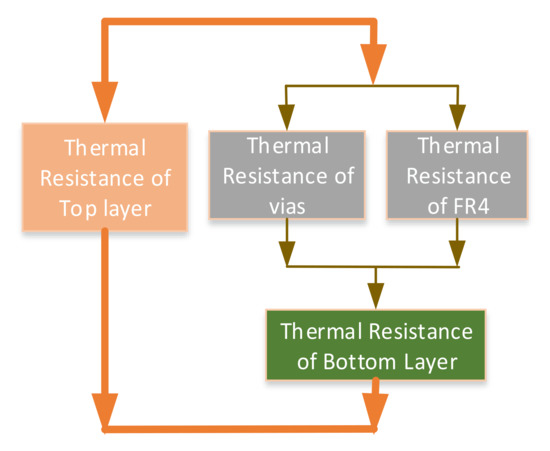
Figure 4.
Schematic thermal resistance of the two PCB layers.
2.3. Heat Transfer
Within the JEDEC enclosure, heat is transferred from the DUT to the PCB and surroundings by three basic mechanisms: conduction, convection, and radiation. Conduction is the process by which heat transfers from high-temperature parts to low-temperature parts that are in contact with each other. In this study, we look mainly at the process of thermal conductivity from the silicon die to the PCB. Figure 5a shows the heat transfer from the semiconductor junction to the copper clip and from the clip to the encapsulate—in addition to the junction through the silicon die to the mounting base, and from the mounting base to the PCB [28].

Figure 5.
(a) Heat dissipate inside IC to copper of PCB and surface of PCB to the air; (b) schematic thermal resistance of two PCB layers and the SMD component.
The heat generated within a device must be transferred through many layers for dispersal to the ambient environment. Figure 5b shows the heat transfer paths and the equations to calculate the transfer rate.
The can be seen as the thermal resistance when the package is mounted on the infinite heat sink by an ideal case-to-heat sink interface. The value of RCS depends on the mounting method.
MOSFET data sheets contain a parameter , the thermal resistance from the junction to the ambient environment. The heat can be dissipated from the device to its surroundings in a typical application. For an SMD, such as an SMD MOSFET, this is highly dependent on the type of PCB on which it is mounted. The type of PCB material, the thickness of copper, and the shape of the copper footprint all contribute to . The is the thermal resistance from the working surface of the silicon crystal to the surrounding environment.
The is defined as the temperature difference between the junction and the ambient environment that transfers one watt of power to the environment. It is given by:
where:
- is measured in °C/W,
- is the junction temperature (°C),
- is the ambient temperature (°C),
- is the heating power dissipated inside MOSFET (W).
For the PCB design, the heat sink area for MOSFETs is selected according to the standardized values in the following Table 2.

Table 2.
Typical and maximum thermal resistance.
2.4. Proposed Signal Generator Method
Among various methods for ultrasound transducer excitation, the radio-frequency linear amplifier delivers the lowest distortion sinusoidal wave over a wide frequency band. Despite these benefits, drawbacks of high-power loss, a bulky size, and heavy weight have limited its use in modern ultrasound transducer excitation circuits. Advances in power electronics technology have led to the proposal of using switched-mode power converters for ultrasound transducer excitation [29,30,31]. A switched-mode power converter with a PWM technique has been used to generate a high-power analog waveform with low harmonic distortion, provided that the switching frequency is at least ten times that of the baseband frequency [30,32]. For baseband frequencies lower than a few tens of kilohertz, the PWM method provides high energy efficiency and, therefore, is used widely in state-of-the-art commercial audio amplifier systems. However, for most HIFU applications, the acoustic frequency ranges from a few hundreds of kilohertz to several megahertz [9,29,33,34]. The use of a switched-mode power converter with the PWM technique would be a challenge because the switching loss of power MOSFETs, which is directly proportional to the switching frequency, would significantly reduce the amplifier efficiency at switching frequency higher than a few megahertz (MHz) [2]. In this study, we used the P-Channel MOSFET (IRF9540) and N-Channel MOSFET (IRF540) to create a multistep sine-shaped signal. The parameters of these two types of MOSFETs are described in Table 3 and Table 4.

Table 3.
Parameters of IRF9540NS (To-263) [35].

Table 4.
Parameters of IRF540NS (To-263) [36].
2.4.1. Ac-Coupled Gate-Drive Circuits
There are many methods to trigger MOSFET. In this study, we used the MOSFET excitation method by using a C capacitor in series between the driver MOSFETs and the MOSFET. The MOSFET driver model using a capacitor is described in Figure 6.
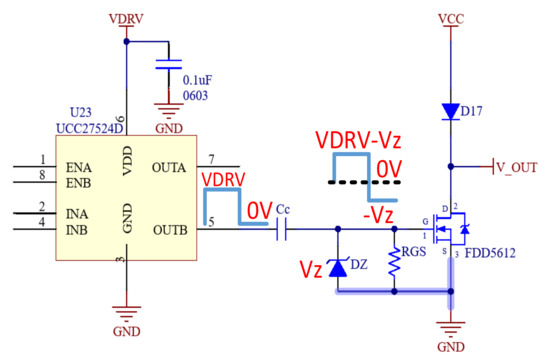
Figure 6.
Proposed MOSFET driver circuit for the HIFU system [37].
Accordingly, the total charge delivered through the coupling capacitor during turn-on, turn-off, and consecutive on time of the MOSFET is shown in Equations (8) and (9). VC determines the voltage across the coupling capacitor shown in Equation (10):
where Fsw is the switching frequency, and D is the duty cycle of Fsw.
2.4.2. Calculating the Coupling Capacitor
The amount of charge going through in every switching cycle causes an alternating current (AC) ripple across the coupling capacitor on the switching frequency basis. The ripple voltage can be calculated based on the charge defined previously, as shown in Equation (11):
Taking into account that = , Equation (12) can be rearranged to yield the desired capacitor value as well:
A good rule of thumb is to limit the worst-case AC ripple amplitude (Δ) to approximately 10% of .
2.4.3. Startup Transient of the Coupling Capacitor
At power-up, the initial voltage across is zero. As the output of the driver starts, switching the direct current (DC) voltage across the coupling capacitor builds up gradually until it reaches its steady-state value, . The duration to develop across depends on the time constant defined by and . Therefore, to achieve a target startup’s transient time and a certain ripple voltage of the coupling capacitor at the same time, the two parameters must be calculated:
which yields a single solution. Substituting the expression for from the second equation, D = 0.5 for the worst-case condition, and targeting Δ = 0.1 × , the first equation can be solved and simplified for a minimum capacitor value as shown in Equation (14):
Once , MIN is calculated, its value and the desired startup time constant (τ) define the required pull-down resistance. A typical design trade-off for AC-coupled drives is to balance efficiency and the transient time constant. The higher current must be allowed in the gate-to-source resistor for a quicker adjustment of the coupling capacitor voltage under varying duty ratios.
2.4.4. Power Dissipation on MOSFETs
Satoshi Tamano and colleagues described the reasons for MOSFET’s destruction in detail. Therefore, in this study, we focus on calculating the power loss of the MOSFET when operating and dissipating this energy by heat dissipation to prevent the MOSFET from being damaged by overheating [12].
During MOSFET operation, energy loss is converted into heat, which occurs mainly in three parts: energy loss on MOSFET, power loss on-resistance, and conduction loss during MOSFET switching. To determine whether or not a MOSFET is suitable for a particular application, we must calculate its power dissipation, which consists mainly of diode power dissipation, resistive, and switching losses [21,22]:
In our example, the conduction losses in the diode are given by the following:
As a MOSFET’s power dissipation depends significantly on its on-resistance, , calculating seems a good place to start. However, a MOSFET’s depends on its junction temperature, TJ. In turn, TJ depends on both the power dissipated in the MOSFET and the thermal resistance, θJA, of the MOSFET. However, to simplify the design and ensure the safety factor, we choose as the maximum value provided by the manufacturer in the datasheet at = 125 °C.
The power loss while the MOSFET turn on (power dissipated on ) is calculated according to the formula:
The power loss during turn-on and turn-off MOSFET is calculated by the following formula:
where is the MOSFET’s reverse–transfer capacitance (a datasheet parameter), is the switching frequency, and is the MOSFET gate driver’s sink/source current at the MOSFET’s turn-on threshold (the VGS of the gate-charge curve’s flat portion).
In addition, to charge the capacitor at the G gate of the MOSFET, the MOSFET driver also needs to use one power. This part of energy is also divided into two main parts: to charge G capacitor and open-close the G gate. This power is calculated using the following formulas:
The total power consumption of the MOSFET driver circuit is calculated by the formula:
The values are found in the datasheet of MOSFET and MOSFET driver (UCC27525) [38].
Based on the MOSFET and MOSFET driver parameters in the datasheet and the HIFU driver system parameters, we have the power dissipation results of the MOSFET described in Table 5 and Table 6.

Table 5.
Power dissipated of IRF9540NS (TO-263).

Table 6.
Power dissipated of IRF540NS (TO-263).
2.4.5. Heat Sink Design
We used the equation
where = 25 °C, = 125 °C, and the and values come from the device datasheets.
We need to perform this calculation for the two different devices, the diode and the MOSFET, but with only one junction from the heat sink to the ambient environment, as we put both devices onto the same heat sink. The losses in both the MOSFET and the freewheeling diode cause temperature differences in the thermal resistor network, as shown in Figure 7.
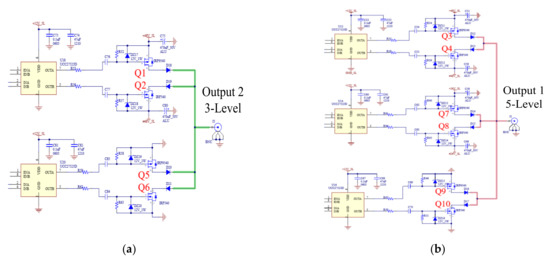
Figure 7.
Proposed HIFU high-power signal generator circuit: (a) output with 3 level, (b) output with 5 level.
Based on the MOSFET operating parameters in Table 2 and Table 3, and the required power dissipation during operation, the cooling parameters for each MOSFET are recalculated and described in Table 7.

Table 7.
Copper area of PCB heat sink for TO-263.
The two types of MOSFET used in the design are IRF540 (N-channel) and IRF9540 (P-channel) used in our design with a package of TO-263 and the heat sink design mentioned in the section above we have the link. The area of PCB needed to dissipate these MOSFET is described in Table 7.
2.4.6. Signal Generator Method
As mentioned above, the HIFU controller system in this study can generate sine signals with five levels. However, when operating at high frequencies, it is possible to use sine signals with three or five levels. The voltage of this sine signal has a peak–peak value of –48 to 48 V. This sine-shaped signal is generated by switching on five pairs of MOSFETs (P-N), with different voltage levels in each MOSFET pairs. Figure 7 describes the names and locations of these MOSFET pairs in our design. The switching order of these MOSFET pairs is shown as follows:
The process of switching a MOSFET to produce a five-step sine wave is described in Figure 8 for a periodic sine wave with cycle . The switching time of MOSFETs is divided into 12 parts, with the smallest division being . Therefore, we can change the MOSFET’s switching time to avoid the Q9 and Q10 MOSFETs operating at high frequencies. For a four-level sine wave, the switching time of the MOSFET is , where T is the period of the desired sine wave.
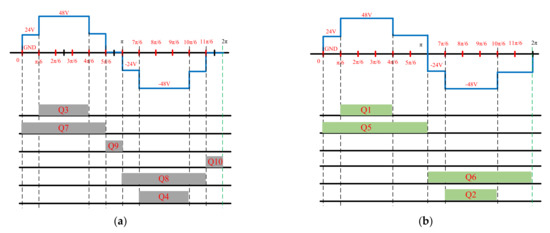
Figure 8.
Proposed sinusoidal signal generator method: (a) five-level, (b) four-level.
3. Implementation of the HIFU System
After completing the calculations for the MOSFET driver circuit as well as the heat dissipation area needed for the MOSFET, we proceeded to design the hardware for this circuit board. The hardware was designed on Altium Designer V.20 software. The software to create MOSFETs was written on the Vivado V17.4 software for the Zynq7000 series made on the ZedBoard kit. Details of these design parts are presented below.
3.1. Circuit Implementation
Figure 9 describes the schematic design and layout of a part of the circuit. In this design, the part includes the MOSFET driver and MOSFET. The component parameters are described in the schematic, and the layout gives the details of these components. The location of these components is essential in optimizing the power MOSFET trigger signal. At the same time, the heat sink for MOSFET is also made by the copper part on the PCB.
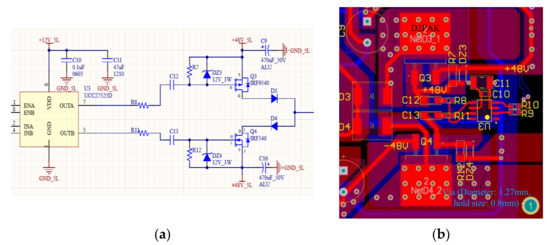
Figure 9.
Proposed MOSFET pair driver circuit for the HIFU system: (a) schematic; and (b) layout with copper thermal dissipation area and thermal vias.
Figure 10 describes the entire layout design of this hardware. Details of the area of the copper heat sink on the circuit on this layout are described in Table 8.
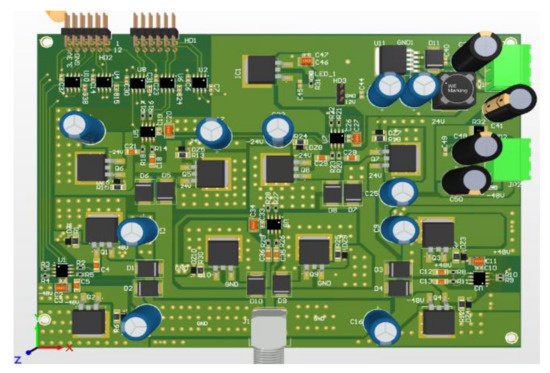
Figure 10.
3D layout of the HIFU high-power signal generator circuit.

Table 8.
Copper area of PCB heat sink for TO-263 with different MOSFETs.
3.2. Firmware Implementation
After completing the implementation hardware, we proceeded with the firmware implementation for the FPGA. This firmware was written on Vivado v17.4 software in VHDL language. The firmware was written for the FPGA chip on ZedBoard and used only the FPGA resource without the Arm 9 core in the chip. The main modules of firmware are described in Figure 11. The clock signal for the system was 100 MHz. The output signal included ten PWM pulses to supply ten MOSFETs to create different types of pulses. In addition, there are ten additional signals that enable PWM out, select the PWM frequency, and select the type of pulse for the transducer.
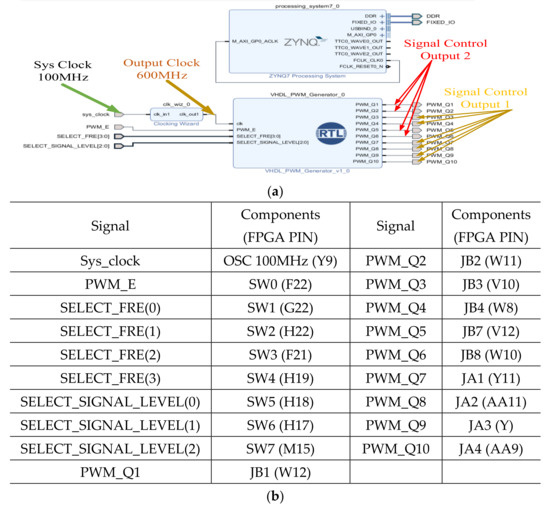
Figure 11.
Firmware (a) design block based on Vivado; (b) signal connection and control MOSFET pair from FPGA to the HIFU power board.
Details of the firmware that generate the MOSFET trigger signal from the FPGA are described in Figure 11. In Figure 11a, we used block diagrams of the Vivado program. The module clocking wizard, ZYNQ7, is the intellectual property (IPs) core provided by Xilinx. We created the IP core VHDL_PWM_Generator in VHDL language to generate PWM signals. Input signals (PWM_E, SELECT_FRE, SELECT_SIGNAL_LEVEL) are connected to SW (0→7) and output signals that are connected to JA and JB ports. Figure 11b details the connections in the firmware.
4. Experimentation and Results
After finishing the hardware and firmware on FPGA, we tested this design. The test steps are as follows. First, we tested the MOSFET excitation signal generated from the FPGA and the output signals of the MOSFET pairs as well as the output sine waveform of this design. Second, we tested the temperatures on the MOSFET with different types of loads and with different capacities to ensure a stable working temperature of the MOSFET. Third, we performed a transducer test to observe and the temperature increase on the HIFU transducer on chicken meat. The experimental system we describe is as in Figure 12.
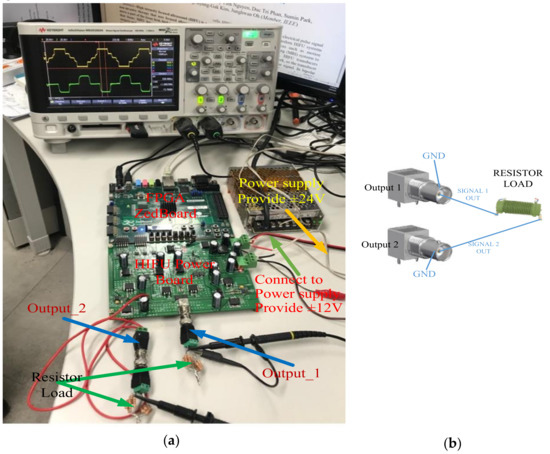
Figure 12.
(a) Setup of the HIFU system with the resistor load, (b) combination of two outputs of the HIFU signal generator circuit.
4.1. Testing the Signal Excitation HIFU Transducer
In this test step, we generated different types of pulses from our designed circuit. The types of pulses generated for testing included bipolar square pulses, three-step sinuses, and five-step sinuses. We used the following equipment for our tests. The source device included three sets of voltage generators +/−24 V, a voltage source of +/−12 V, an oscilloscope device (MSOX 2024A) to view signals, and electrical load devices for power consumption. Figure 13 describes the signals generated from the FPGA to trigger MOSFETs to create a 5-level sine wave signal.

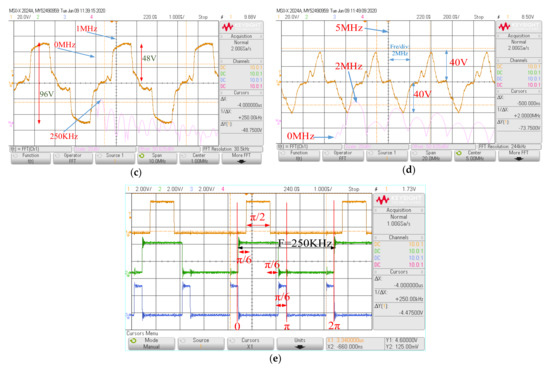
Figure 13.
The output signal of HIFU power board: single output at frequency (a) 250 kHz, (b) 1 MHz, two outputs become one output at frequency (c) 250 kHz, (d) 1 MHz, (e) signal control MOSFET pair from FPGA with a five-level signal output and a frequency at 250 kHz.
Based on Figure 13a, we saw clearly that, at low-frequency (250 kHz), the output signal is described clearly as a five-step sine signal. However, at a higher frequency Figure 13b (1 MHz), the signal is no longer clearly distinguishable as before.
Figure 13c,d clearly describes the combination of two outputs that produce a signal with twice the voltage of a single signal (96 V versus 48 V), which also means more power to the load. With the low-frequency signal (250 kHz), the distinction between signal levels is quite clear, and the energy is highly concentrated at the central frequency (250 kHz). However, with a higher frequency (2 MHz), the output signal is distorted, and the distinctions of the ranks are no longer clear, but the energy is still highly concentrated at the central frequency (2 MHz).
In Figure 13e, there is a PWM signal generated from the FPGA to generate a 5-order sine wave with a frequency of 250 KHz. These signals with an amplitude of 3.3 V are fed into two PINs (INA and INB) of the MOSFET driver UCC27525. The signal OUTA of UCC27525 will trigger the P Channel MOSFET and the signal OUTB of UCC27525 will trigger the N channel MOSFET.
4.2. Evaluate the Ultrasound Wave Generated from the HIFU Transducer
In this test, we measured the shape and intensity of the ultrasonic generated by the HIFU controller board with a 5-step sine wave and a 2-step square wave. We then evaluate the efficiency of a 5-step sine wave compared to a 2-step square wave with the HIFU transducer. The experimental model is described in Figure 14.

Figure 14.
(a) Block diagram of HIFU experiment system; (b) the real HIFU experiment system.
Tests included a HIFU controller board to generate a 5-step sine wave and a 2- step square wave to trigger the HIFU transducer (2 MHz). The ultrasonic wave signal is captured by a high frequency transducer to assess the intensity and harmonics of the ultrasonic waves produced by the HIFU transducer. The signal from the high frequency transducer is fed into a 40 dB amplifier module operating at 12 V. The output signal of the amplifier module will be observed on the oscilloscope (MSOX 2024A).
Based on the results described in Figure 15a,b, we clearly see that the ultrasonic signal generated by the 5-level sine wave has a higher amplitude (Peak-Peak as 3.3 V with 5-level and 1.17 V with 2-level), and the lower harmonic is smaller than the 2-level sine wave. These are also outstanding advantages of the 5-step sine method using HIFU transducer control compared to the conventional square wave method. Therefore, the energy efficiency and the heat generating effect using the 5-step sine wave are also much higher than that of the 2-step square wave.
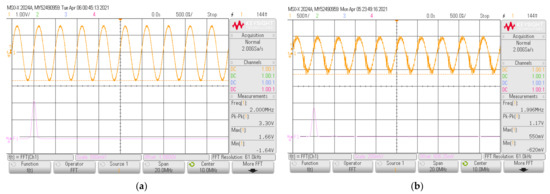
Figure 15.
Output signal from high frequency transducer with: (a) 5-level sine wave, (b) 2-level square wave for excitation 2 MHz HIFU transducer.
4.3. Electrical Power Consumption and MOSFET Temperature Rise
In this test, we measured the temperature and energy consumption of the HIFU board with the resistor load type. We used a 50-Ohm resistor as the load. The test model is described in Figure 12 and Figure 16a. The power supply for the circuit board is described as shown in Figure 16a. We used four power supplies for the HIFU board, including +/−24 V and +/−12 V. The test was carried out in a laboratory with a temperature of about 20 °C. We kept the circuit board running continuously for a period of 5 min. The test was conducted with channel 1 and the combination of channels 1 and 2. The energy consumption results are described in Table 9 and Table 10 and Figure 16.
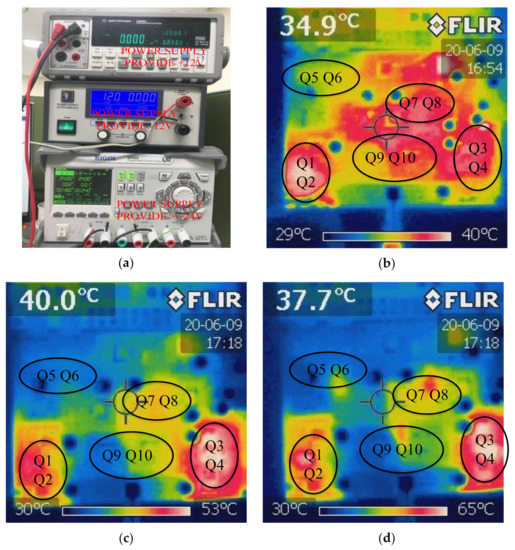
Figure 16.
Thermal dissipation of power MOSFETs on PCB with a combination of two outputs: (a) at frequency 250 kHz, (b) at frequency 1 MHz, and (c) at frequency 2 MHz, (d) at frequency 3 MHz.

Table 9.
Power consumption on channel 1 with differences in voltage level.

Table 10.
Combination of two-channel power consumption with differences in voltage level.
The results described in Table 9 and Table 10 are the average values we observed and calculated based on the measuring devices in about 5 minutes of operation of the HIFU board.
Based on the results described in Table 9 and Table 10, we see that, when the frequency of the HIFU board output signal is increased, the power consumption on the +/−12 V part reduces the load power to the load mainly depending on the +/−24 V source.
As the frequency increases, so does the power of the power supply, and the heat dissipation on the MOSFETs is greater. When channel 1 is combined, two energy transmits to the load increasing cavity 1.5 times compared to channel 1 only.
The results are described in Figure 16, which was taken with a thermal camera (FLIR i5). Based on the results in Figure 16, we can see clearly that, when operating at a low-frequency of 250 kHz, the heat dissipation on the circuit board is quite even in three areas: (Q1, Q2), (Q3, Q4), and (Q7, Q8). However, the temperature on the MOSFETs (about 40 °C) is also nearly two times higher than the ambient temperature (20 °C).
For frequencies higher than 1 and 2 MHz, the increase in temperature in the MOSFET region (Q3, Q4) is the highest, followed by region (Q1, Q2). The temperature on the MOSFETs (about 65 °C) is always three times higher than the ambient temperature (about 20 °C). The MOSFETs produce a relatively large amount of heat.
In PCB, the heatsink areas for MOSFET (Q1, Q2) and (Q3, Q4) are quite similar. However, the temperature of MOSFETs Q1 and Q3 is higher than Q2 and Q4 because the P-Channel MOSFETs dissipate more heat during operation time.
4.4. Testing Thermal Generator with HIFU Transducer and Chicken Meat
In this test, we measured the thermal tissue damage ability (we used chicken for testing) of the HIFU system we designed above. The HIFU transducer we used H-148 (from SONIC USA [34]). The experimental model is described in Figure 17. For the power supply, we used the source as described in Figure 16a. As the HIFU transducer H-148 operates at 2 MHz, experiments were conducted only at 2 MHz. Experiments included using channel 1 to activate a HIFU transducer and combining channels 1 and 2 to activate a HIFU transducer. The results are described in Figure 17b.
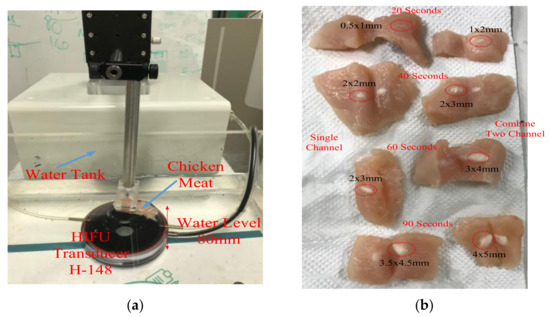
Figure 17.
(a) Setup of the HIFU transducer with chicken meat and a water tank, (b) comparison of the burned area of chicken meat, using the HIFU system with a different time between the single channel output and the combined two outputs.
Based on the results described in Figure 17b, we can see that the captured chicken tumor is burned after about 20 s. When the time was increased to 40 s, the area quickly destroyed the spread by about six times. When the time was increased to 60 s, the area of destruction continued to increase by two times compared to the previous one. When the time was increased to 90 s, the area of tissue destruction continued to increase many times compared to the previous tests.
Our tests were conducted with channel 1 and the combined channels 1 and 2. The results in Figure 17b show that the destroyed tissue area of the combined channel is much larger than that of channel 1 alone. This has significant implications for markedly reducing the HIFU treatment time.
In addition, during the experiment, we found that the unstable energy dissipation usually fluctuates. This may be caused by the unstable operation of the HIFU load. During the operation, HIFU generates sound waves and creates water waves, leading to changes in the water section in the water tank. In addition, the temperature of the MOSFETs increased; we installed a small fan in areas (Q1, Q2) and (Q3, Q4). The total power consumption of these two fans was 1.5 W. We noticed that the power consumption decreased after we installed the fan. The results are described in Figure 18.
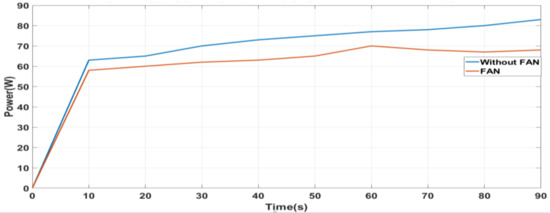
Figure 18.
Comparison of the power consumption of the HIFU system with and without the fan.
Based on the results in Figure 18, we can see that the working capacity of the HIFU transducer is about 60 W. The MOSFETs get hot after a period of operation, which leads to an increased power consumption of 80 W. The use of additional fans will help dissipate thermal energy faster and bring the power down to about 65 W. Failure to use the fan may result in the burning of the MOSFET. Using a fan also saves about 10% in energy.
After performing tests to evaluate the design, we make a table comparing this design with previous works. The results are described in Table 11.

Table 11.
The comparison with previous research.
The results described in Table 11 show that our design has outstanding features compared with previous studies. The advancements described include operating frequency range, output power, output voltage, and output signal type. These parameters are well suited for many HIFU applications.
5. Conclusions
In this study, we presented the complete design of a HIFU system (HIFU-01, Ohlabs Corp., Nam-gu, Busan, Korea, (accessed on 15 May 2020, www.ohlabs.co.kr) for tissue burning. The transducer excitation frequency is adjustable from 0.1 to 5 MHz. The maximum output power is about 100 W, and the maximum supply voltage is about 60 V.
Our design can be used with two outputs simultaneously. The control signal is built on the FPGA platform, so it is very flexible when changes are needed. The hardware design mainly used is the SMD-type MOSFETs, with the heat sink design done directly on the PCB without an additional heat sink. The design can combine two channels into one, with the output power increased by 1.5 times compared to using only one channel. The output signals are carried out with a multistep sine wave, which helps reduce the harmonics of the signal.
The use of a 5-level sine wave to excite the HIFU transducer has been shown to be significantly effective when the sound wave intensity at the center frequency is greater and the high harmonic is smaller than the conventional square wave method. This is of therapeutic importance in helping to reduce treatment time and reduce damage to healthy cells.
In the chicken marketing test, we can clearly see the advantage of combining two output signals with burning chicken tissue faster than using just one channel. This design also doubles the voltage of the output signal compared to the supply voltage. For large power consumption and long-term design, it is necessary to install a cooling fan. The cooling fan helps to increase the components’ lifespan and also helps to save on the energy of the system.
Author Contributions
Conceptualization, supervision, and funding acquisition, J.O.; methodology, N.T.B.; software, N.T.B., G.Y.A., T.T.N.D., and Q.C.B.; validation, and J.O.; writing—original draft preparation, N.T.B., T.M.T.N., S.P., D.T.P., J.C., and T.T.H.V., writing—review and editing, all authors. All authors have read and agreed to the published version of the manuscript.
Funding
This research was supported by Pukyong National University Development Project Research Fund (Philosopher of Next Generation), 2020.
Conflicts of Interest
The authors declare no conflict of interest.
References
- Suomi, V.; Jaros, J.; Treeby, B.; Cleveland, R.O. Full Modeling of High-Intensity Focused Ultrasound and Thermal Heating in the Kidney Using Realistic Patient Models. IEEE Trans. Biomed. Eng. 2018, 65, 2660–2670. [Google Scholar] [CrossRef] [PubMed]
- He, P.Z.; Shi, R.M.X.; Duan, M.; Shou, W.D.; Qian, D.C. The affection on the tissue lesions of difference frequency in dual-frequency high-intensity focused ultrasound (HIFU). Ultrason. Sonochem. 2006, 13, 339–344. [Google Scholar] [CrossRef] [PubMed]
- Zhou, Y.; Yu, Z.; Ma, Q.; Guo, G.; Tu, J.; Zhang, D. Noninvasive Treatment-Efficacy Evaluation for HIFU Therapy Based on Magneto-Acousto-Electrical Tomography. IEEE Trans. Biomed. Eng. 2019, 66, 666–674. [Google Scholar] [CrossRef] [PubMed]
- Tianhan Tang, T.A.; Toshihide, I.; Hideki, T.; Etsuko, K.; Ichiro, S. A High-Precision US-Guided Robot-Assisted HIFU Treatment System for Breast Cancer. Engineering 2018, 4, 702–713. [Google Scholar] [CrossRef]
- King, R.L.; Liu, Y.; Maruvada, S.; Herman, B.A.; Wear, K.A.; Harris, G.R. Development and characterization of a tissue-mimicking material for high-intensity focused ultrasound. IEEE Trans. Ultrason. Ferroelectr. Freq. Control 2011, 58, 1397–1405. [Google Scholar] [CrossRef]
- Qu, X.; Azuma, T.; Sugiyama, R.; Kanazawa, K.; Seki, M.; Sasaki, A.; Takeuchi, H.; Fujiwara, K.; Itani, K.; Tamano, S.; et al. Improved highly accurate localized motion imaging for monitoring high-intensity focused ultrasound therapy. Jpn. J. Appl. Phys. 2016, 55, 07KF04. [Google Scholar] [CrossRef]
- Yoshizawa, S.; Takagi, R.; Umemura, S.-I. Enhancement of High-Intensity Focused Ultrasound Heating by Short-Pulse Generated Cavitation. Appl. Sci. 2017, 7, 288. [Google Scholar] [CrossRef]
- Li, T.; Khokhlova, T.D.; Sapozhnikov, O.A.; O’Donnell, M.; Hwang, J.H. A new active cavitation mapping technique for pulsed HIFU applications-bubble doppler. IEEE Trans. Ultrason. Ferroelectr. Freq. Control 2014, 61, 1698–1708. [Google Scholar] [CrossRef]
- Adams, C.; Carpenter, T.M.; Cowell, D.; Freear, S.; McLaughlan, J.R. HIFU Drive System Miniaturization Using Harmonic Reduced Pulsewidth Modulation. IEEE Trans. Ultrason. Ferroelectr. Freq. Control 2018, 65, 2407–2417. [Google Scholar] [CrossRef]
- Farhanieh, O.; Sahafi, A.; Roy, R.B.; Ergun, A.S.; Bozkurt, A. Integrated HIFU Drive System on a Chip for CMUT-Based Catheter Ablation System. IEEE Trans. Biomed. Circuits Syst. 2017, 11, 534–546. [Google Scholar] [CrossRef]
- Adams, C.; McLaughlan, J.R.; Carpenter, T.M.; Freear, S. HIFU Power Monitoring Using Combined Instantaneous Current and Voltage Measurement. IEEE Trans. Ultrason. Ferroelectr. Freq. Control 2020, 67, 239–247. [Google Scholar] [CrossRef]
- Satoshi Tamano, S.Y.; Umemura, S.I. Multifunctional pulse generator for high-intensity focused ultrasound system. Jpn. J. Appl. Phys. 2017, 56, 07JF21. [Google Scholar] [CrossRef]
- Choi, H. Development of negative-group-delay circuit for high-frequency ultrasonic transducer applications. Sens. Actuators A Phys. 2019, 299, 111616. [Google Scholar]
- Bui, N.T.; Nguyen, T.M.T.; Dinh, T.T.N.; Bui, Q.C.; Vo, T.H.; Phan, D.T.; Park, S.; Choi, J.; Kang, Y.-H.; Kim, B.-G.; et al. Design of a Multichannel Pulser/Receiver and Optimized Damping Resistor for High-Frequency Transducer Applied to SAM System. Appl. Sci. 2020, 12, 8388. [Google Scholar] [CrossRef]
- Lorton, O.; Guillemin, P.C.; Mori, N.; Crowe, L.A.; Boudabbous, S.; Terraz, S.; Becker, C.D.; Cattin, P.; Salomir, R.; Gui, L. Self-Scanned HIFU Ablation of Moving Tissue Using Real-Time Hybrid US-MR Imaging. IEEE Trans. Biomed. Eng. 2019, 66, 2182–2191. [Google Scholar] [CrossRef]
- Ku, P.-C.; Shih, K.-Y.; Lu, L.-H. A High-Voltage DAC-Based Transmitter for Coded Signals in High Frequency Ultrasound Imaging Applications. IEEE Trans. Circuits Syst. I 2018, 65, 2797–2809. [Google Scholar] [CrossRef]
- Huang, S.-W.; Li, P.-C. Arbitrary waveform coded excitation using bipolar square wave pulsers in medical ultrasound. IEEE Trans. Ultrason. Ferroelectr. Freq. Control 2006, 53, 106–116. [Google Scholar] [CrossRef]
- Dzung, P.Q.; Lee, H.H.; Thang, B.N. A new FPGA implementation of four- switch three- phase inverter. In Proceedings of the 2009 International Conference on Power Electronics and Drive Systems (PEDS), Taipei, Taiwan, 2–5 November 2009. [Google Scholar]
- Christoffersen, C.; Wong, W.; Pichardo, S.; Togtema, G.; Curiel, L. Class-DE Ultrasound Transducer Driver for HIFU Therapy. IEEE Trans. Biomed. Circuits Syst. 2016, 10, 375–382. [Google Scholar] [CrossRef]
- Kim, J.; Choi, W.; Park, E.-Y.; Kang, Y.; Lee, K.J.; Kim, H.H.; Kim, W.J.; Kim, C. Real-Time Photoacoustic Thermometry Combined with Clinical Ultrasound Imaging and High-Intensity Focused Ultrasound. IEEE Trans. Biomed. Eng. 2019, 66, 3330–3338. [Google Scholar] [CrossRef]
- Künzi, R. Thermal Design of Power Electronic Circuits; CERN Accelerator School: Power Converters: Baden, Switzerland, 2016. [Google Scholar]
- Caillaud, R.; Buttay, C.; Mrad, R.; Le Lesle, J.; Morel, F.; Degrenne, N.; Mollov, S.V. Thermal Considerations of a Power Converter with Components Embedded in Printed Circuit Boards. IEEE Trans. Compon. Packag. Manuf. Technol. 2019, 10, 230–239. [Google Scholar] [CrossRef]
- Oueslati, R.B.; Therriault, D.; Martel, S. PCB-Integrated Heat Exchanger for Cooling Electronics Using Microchannels Fabricated With the Direct-Write Method. IEEE Trans. Compon. Packag. Technol. 2008, 31, 869–874. [Google Scholar] [CrossRef]
- Serkan, D.; Yong, X.; Beheshti, M.; Brohlin, P. Thermal Considerations for Designing a GaN Power Stage. Application Report (SNOAA14A–October 2018); Texas Instruments: Dallas, TX, USA, 2018. [Google Scholar]
- Hou, F.; Wang, W.; Lin, T.; Cao, L.; Zhang, G.Q.; Ferreira, J.A. Characterization of PCB Embedded Package Materials for SiC MOSFETs. IEEE Trans. Compon. Packag. Manuf. Technol. 2019, 9, 1054–1061. [Google Scholar] [CrossRef]
- Renesas. AN-842 Thermal Considerations in Package Design and Selection; Renesas: Tokyo, Japan, 2014. [Google Scholar]
- Fan, J.; Ye, X.; Kim, J.; Archambeault, B.; Orlandi, A. Signal Integrity Design for High-Speed Digital Circuits: Progress and Directions. IEEE Trans. Electromagn. Compat. 2010, 52, 392–400. [Google Scholar] [CrossRef]
- TN90001, n. LFPAK MOSFET Thermal Resistance Rth(j-a) Simulation, Test and Optimisation of PCB Layout; Nexperia: Nijmegen, The Netherlands, 2018.
- Giannelli, P.; Bulletti, A.; Granato, M.; Frattini, G.; Calabrese, G.; Capineri, L. A Five-Level, 1-MHz, Class-D Ultrasonic Driver for Guided-Wave Transducer Arrays. IEEE Trans. Ultrason. Ferroelectr. Freq. Control 2019, 66, 1616–1624. [Google Scholar] [CrossRef]
- Lakka, M.; Koutroulis, E.; Dollas, A. Development of an FPGA-Based SPWM Generator for High Switching Frequency DC/AC Inverters. IEEE Trans. Power Electron. 2014, 29, 356–365. [Google Scholar] [CrossRef]
- Ceglia, G.; Guzman, V.; Sanchez, C.; Ibanez, F.; Walter, J.; Gimenez, M. A New Simplified Multilevel Inverter Topology for DC–AC Conversion. IEEE Trans. Power Electron. 2006, 21, 1311–1319. [Google Scholar] [CrossRef]
- Xu, S. A New Multilevel AC/DC Topology Based H-Bridge Alternate Arm Converter. IEEE Access 2020, 8, 57997–58005. [Google Scholar] [CrossRef]
- Tang, S.C.; Clement, G.T. A harmonic cancellation technique for an ultrasound transducer excited by a switched-mode power converter. In Proceedings of the 2008 IEEE Ultrasonics Symposium, Beijing, China, 2–5 November 2008. [Google Scholar]
- H- Transducer Series Ø64 mm with Ø20 mm Opening; Sonic Concepts Inc.: Bothell, WA, USA, 2018.
- IRF9540NS Datasheet; Infineon: Munich, Germany, 2018.
- IRF540 Datasheet; Infineon: Munich, Germany, 2018.
- Fundamentals of MOSFET and IGBT Gate Driver Circuits; Texas Instruments: Dallas, TX, USA, 2018.
- UCC27525 Datasheet; Texas Instruments: Dallas, TX, USA, 2018.
- Park, S.; Pham, N.T.; Huynh, H.-T.; Kang, H.W. Development of temperature controller-integrated portable HIFU driver for thermal coagulation. Biomed. Eng. Online 2019, 18, 1–13. [Google Scholar] [CrossRef]
- Lewis, G.K., Jr.; Olbricht, W.L. Development of a portable therapeutic and high intensity ultrasound system for military, medical, and research use. Rev. Sci. Instrum. 2009, 79, 114302. [Google Scholar] [CrossRef]
Publisher’s Note: MDPI stays neutral with regard to jurisdictional claims in published maps and institutional affiliations. |
© 2021 by the authors. Licensee MDPI, Basel, Switzerland. This article is an open access article distributed under the terms and conditions of the Creative Commons Attribution (CC BY) license (https://creativecommons.org/licenses/by/4.0/).